Book contents
- Frontmatter
- Contents
- List of figures and tables
- Notes on contributors
- Foreword
- Preface
- Part I Roles and responsibilities
- Part II Materials and collection management
- Part III Teaching and learning
- 14 Embedded in their world: moving mentally into the studio environment
- 15 Teaching with threshold concepts and the ACRL Framework in the art and design context
- 16 Teaching by the book: art history pedagogy and special collections
- 17 Metaliteracy in art and design education: implications for library instruction
- 18 The art of evidence: a method for instructing students in art history research
- 19 ‘I want students to research the idea of red’: using instructional design for teaching information literacy in the fine arts
- 20 Cultural differences and information literacy competencies
- Part IV Knowledge creation
- Part V The physical environment
- Part VI Promotion and sustainability
- Appendix Library profiles
- Index
17 - Metaliteracy in art and design education: implications for library instruction
from Part III - Teaching and learning
Published online by Cambridge University Press: 08 June 2018
- Frontmatter
- Contents
- List of figures and tables
- Notes on contributors
- Foreword
- Preface
- Part I Roles and responsibilities
- Part II Materials and collection management
- Part III Teaching and learning
- 14 Embedded in their world: moving mentally into the studio environment
- 15 Teaching with threshold concepts and the ACRL Framework in the art and design context
- 16 Teaching by the book: art history pedagogy and special collections
- 17 Metaliteracy in art and design education: implications for library instruction
- 18 The art of evidence: a method for instructing students in art history research
- 19 ‘I want students to research the idea of red’: using instructional design for teaching information literacy in the fine arts
- 20 Cultural differences and information literacy competencies
- Part IV Knowledge creation
- Part V The physical environment
- Part VI Promotion and sustainability
- Appendix Library profiles
- Index
Summary
The concept of metaliteracy
The term ‘metaliteracy’ is still a relatively new concept since being introduced into the library and information science literature as a ‘framework that integrates emerging technologies and unifies multiple literacy types’ (Jacobsen and Mackey, 2011, 62). It is therefore still a fairly recent addition to the parlance surrounding library instruction and teaching and learning practice, which this chapter will attempt to expand on. In the first edition of this handbook, there was no corresponding chapter; instead, there was a comprehensive ‘teaching and learning’ section with chapters covering themes such as visual literacy (Gluibizzi, 2010), embedding information literacy (Mayer, 2010), and using image databases (Roberto and Robinson, 2010). The inclusion of such chapters suggests that as a profession we were still in the habit of regarding individual literacies and talking about them as a group of literacies. However, a later chapter discussed how multiple literacies are best served in the art and design library and how librarians need to accommodate how visual and kinaesthetic learners access, organize and use information (Wilson and McCarthy, 2010).
At the heart of metaliteracy in an art and design context is the acknowledgement that art and design students learn ‘differently’ and that subsequently, this difference needs to be considered when developing information literacy instruction. Writing in 2008, Halverson suggested that there ‘were few, if any, existing formulas in place to create information literacy programmes that adequately address the particular and idiosyncratic needs of arts students’ (2008, 34). While there has been much discussion and development within the area of information literacy for art and design students since 2008, there remains a need to acknowledge the ‘difference’ and to establish learning frameworks accordingly. Greer (2015) considers the notion of art itself within an information literacy context and in doing so reflects on the artistic practices of ‘creating meaning from personal experience; forging connections with larger concepts and cultural references; and encouraging the practice of self-reflection’ (84).
Metaliteracy models
Within this information literacy context, metaliteracy models lend themselves to arts education and learning, but before expanding on this, it is first useful to identify which component parts go into such a model.
- Type
- Chapter
- Information
- The Handbook of Art and Design Librarianship , pp. 169 - 178Publisher: FacetPrint publication year: 2017



